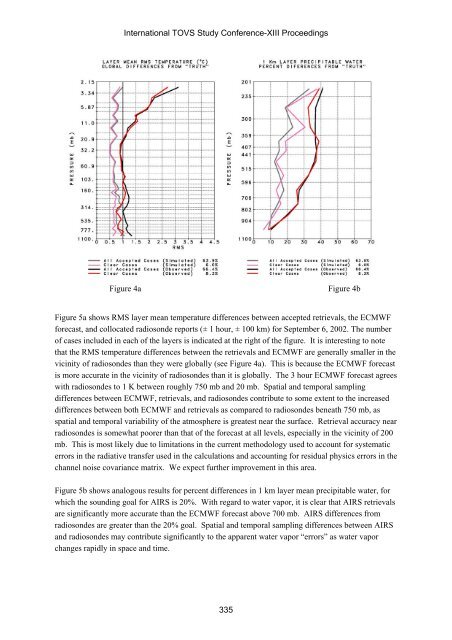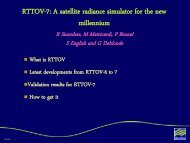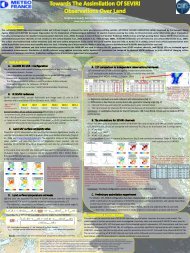Current results from AIRS/AMSU/HSB
Current results from AIRS/AMSU/HSB
Current results from AIRS/AMSU/HSB
Create successful ePaper yourself
Turn your PDF publications into a flip-book with our unique Google optimized e-Paper software.
International TOVS Study Conference-XIII Proceedings<br />
Figure 4a<br />
Figure 4b<br />
Figure 5a shows RMS layer mean temperature differences between accepted retrievals, the ECMWF<br />
forecast, and collocated radiosonde reports (± 1 hour, ± 100 km) for September 6, 2002. The number<br />
of cases included in each of the layers is indicated at the right of the figure. It is interesting to note<br />
that the RMS temperature differences between the retrievals and ECMWF are generally smaller in the<br />
vicinity of radiosondes than they were globally (see Figure 4a). This is because the ECMWF forecast<br />
is more accurate in the vicinity of radiosondes than it is globally. The 3 hour ECMWF forecast agrees<br />
with radiosondes to 1 K between roughly 750 mb and 20 mb. Spatial and temporal sampling<br />
differences between ECMWF, retrievals, and radiosondes contribute to some extent to the increased<br />
differences between both ECMWF and retrievals as compared to radiosondes beneath 750 mb, as<br />
spatial and temporal variability of the atmosphere is greatest near the surface. Retrieval accuracy near<br />
radiosondes is somewhat poorer than that of the forecast at all levels, especially in the vicinity of 200<br />
mb. This is most likely due to limitations in the current methodology used to account for systematic<br />
errors in the radiative transfer used in the calculations and accounting for residual physics errors in the<br />
channel noise covariance matrix. We expect further improvement in this area.<br />
Figure 5b shows analogous <strong>results</strong> for percent differences in 1 km layer mean precipitable water, for<br />
which the sounding goal for <strong>AIRS</strong> is 20%. With regard to water vapor, it is clear that <strong>AIRS</strong> retrievals<br />
are significantly more accurate than the ECMWF forecast above 700 mb. <strong>AIRS</strong> differences <strong>from</strong><br />
radiosondes are greater than the 20% goal. Spatial and temporal sampling differences between <strong>AIRS</strong><br />
and radiosondes may contribute significantly to the apparent water vapor “errors” as water vapor<br />
changes rapidly in space and time.<br />
335








